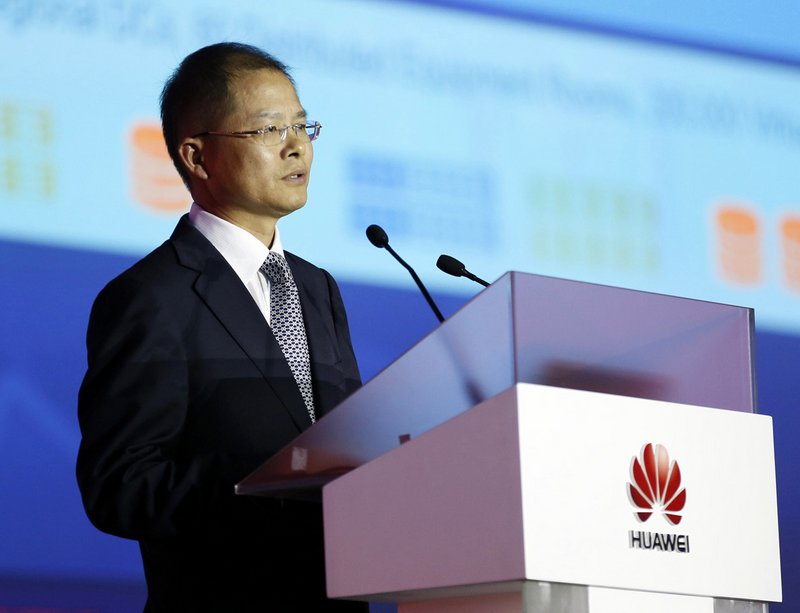Background
Tencent ranks as the largest Internet enterprise in Asia and third largest services provider worldwide, after Google and Amazon. It serves the most users in China and is Asia’s first Internet enterprise with over USD $100 billion market value. Tencent provides a wide range of online services, gaining strength in mobile services, including gaming, social communities, advertising, reading, videos, music, and eCommerce, which are top-ranking in China’s Internet and mobile industries.
Challenges
To support heavy Internet service traffic, Tencent installed over 300,000 servers running on the live network and has purchased nearly 10 percent of all servers in the Chinese market in recent years.

Eric Xu speaks at a tech conference in 2014(file photo).
Tencent annually spends over USD $1.57 million on electricity. A majority of Tencent’s rack servers were set up in carriers’ equipment rooms. Electricity fees and rack rentals accounted for a large proportion of operating expenses (OPEX). Tencent urgently needed energy-saving, high-density servers to minimize OPEX.
Server stability was critical to Tencent since operations required real-time service systems. Server bottlenecks would deteriorate service performance or interrupt services, affecting user experiences and eventually resulting in huge revenue losses.
Installation took over 5 hours to deploy 20 servers in a rack, which slowed down service implementation as well as system responses to surging Internet user demand. As services grew rapidly and became increasingly diversified, Tencent’s business departments began using all different types of servers with as many as 28 different types of configurations. These various systems created huge challenges for server selection and testing, Operations and Maintenance (O&M), and purchase forecasting. Tencent’s IT architecture needed to be optimized immediately to enable flexible deployment and faster implementation of services.
Solution
Huawei has been an Information Technology (IT) partner for Tencent since 2008. Huawei provided Tencent with a full series of servers, including 1U or 2U rack servers, blade servers, high-density servers, and X8000 servers. Huawei servers were Tencent’s optimal choice as the products were efficient to deploy, provided high performance, and lower power consumption.
Optimal design and high energy efficiency
To reduce power consumption, Huawei and Tencent set up a joint innovation team, which obtained and analyzed Tencent’s detailed O&M data over recent years. The resulting analysis indicated that the average server utilization rate was only 25 percent, while the web access server utilization rate was only 15 percent. To resolve these issues, Huawei recommended the following optimized solution:
- Workstation CPUs with lower power consumption would replace server CPUs, reducing power consumption of web access servers by 50 percent and doubling deployment density. As a result, OPEX would decrease by 25 percent
- Removal of extended server functions, which had never been used, would further lower power consumption by another 10 percent
Selecting components with lower failure rates
Troubleshooting statistics over the past two years showed that the server failure rate also remained high. The major cause was that complex, diverse server configurations made in-depth optimization of each model impossible. The joint innovation team placed reduction of failure rates as a top priority. The team then analyzed differences and similarities of the existing configurations, narrowing down the selection to five types from the prior 28, after reviewing common features and personalized service requirements. As a result of the analysis, elimination of failure-prone components dropped the failure rate by 50 percent.
Unified architecture and high deployment density
During the solution optimization process, the joint innovation team considered IT architecture flexibility and smooth evolution from 1U and 2U rack servers to X6000 server nodes in 2U chassis, then to X8000 servers. Nodes with different configurations shared the same chassis, power system, and ports, which enabled technical continuity and maximized the customer’s Return On Investment (ROI).
Integrated delivery and simple maintenance
After optimization, 2U chassis were used in place of chassis of different specifications, which significantly improved deployment efficiency during installation by simply connecting power and network cables. Additionally, system administrators can maintain Huawei servers from the front which facilitates maintenance, especially all nodes on X6000 servers.
Benefits
Over 100,000 Huawei servers have been deployed on Tencent’s demanding network by the end of 2013, designating Huawei as Tencent’s largest server vendor. Huawei servers not only meet the current requirements of Tencent, but also support its future service growth. These servers offer significant technical and service advantages by providing highly reliable, quickly customizable products with powerful troubleshooting services. Other key advantages of selecting Huawei’s servers include:
- Lower TCO: High-density deployment has reduced equipment footprint by 50 percent, power consumption by 15 percent, which has slashed TCO by USD $15.7 million annually.
- Minimal failure rates: Optimal server selection, configuration, and testing allows for simpler O&M and less product failures. Carrier-class components, excellent design, and manufacturing processes have reduced the possibility of batch faults.
- Higher deployment efficiency and management: The time required for deploying 20 servers in a rack is reduced from 5 hours to 10 minutes. Huawei servers support automatic fault detection and reporting which facilitates O&M.